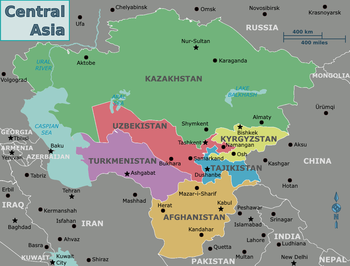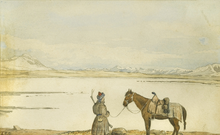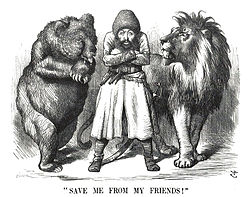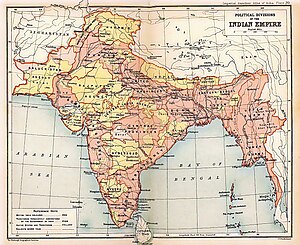Great Game


"The Great Game" is a term commonly used in international politics, academia and journalistic publications to describe the competition that emerged during the 19th Century between the British Empire and the Russian Empire in a mutual conquest for territories situated between each individual empire's "colonial possessions", therefore primarily centered around Afghanistan and its surrounding regions. [1] British intelligence suspected Russia's goal to be access to warm-water ports at the Persian Gulf or potentially valuable Indian territories and therefore wanted to prevent Russia's expansion. [2] From the British perspective, the Russian Empire's expansion into Central Asia threatened to destroy the "jewel in the crown" of the British Empire, India. The British feared that the Russians would subdue the Central Asian khanates one after another, and then the Emirate of Afghanistan might then become a staging post for a Russian invasion of India. From the Russian perspective, British commercial and military expansion into Central Asia was feared. One of the most common uses of the term in academia assumes that the original Great Game describes events that happened approximately from the Russo-Persian Treaty of 1813 (Treaty of Gulistan) to the Anglo-Russian Entente of 1907. This period was followed by the 1907 Bolshevik October Revolution, a slightly less tumultuous phase. After the end of World War II and the end of colonialism, the term continued to be commonly used to describe the geopolitical machinations of the "Great Powers" and regional powers as they engage in rivalry surrounding geopolitical power and influence related to Central Asia. [3]
After the fall of the British Empire and the emergence of the US as the dominant global power, the continuing process of rivalry surrounding major nations in those regions and beyond are commonly being described as the New Great Game.
Etymology

The term The Great Game is used in academic, political and popular contexts and was used well before the 19th century and was associated with games of risk - cards and dice. The French equivalent Le gros jeu dates back to at least 1585 and is associated with meanings of risk, chance and deception.[4]: 183
In the summer of 1840, the principle British agent in Afghanistan, Sir William Hay Macnaghten, argued in a letter for the annexation of Herat in western Afghanistan by the British, and stated:
We have a beautiful game on our hands.[5]
The term "The Great Game" is attributed to Arthur Conolly (1807–42), an intelligence officer of the 6th Bengal Light Cavalry.[6] In July 1840, in a correspondence with Major Henry Rawlinson who had been recently appointed as the new political agent in Kandahar, Conolly stated:
You've a great game, a noble game, before you.[7]
Conolly believed that Rawlinson's new post gave him the opportunity to advance humanitarianism in Afghanistan, and summed up his hopes:[4]
If the British Government would only play the grand game — help Russia cordially to all that she has a right to expect — shake hands with Persia — get her all possible amends from Oosbegs — force the Bokhara Amir to be just to us, the Afghans, and other Oosbeg states, and his own kingdom — but why go on; you know my, at any rate in one sense, enlarged views. Inshallah! The expediency, nay the necessity of them will be seen, and we shall play the noble part that the first Christian nation of the world ought to fill.[8]
One common popular use of the term is related to spies and their military value or political influence on the peoples of a region. [4] It was introduced into mainstream consciousness by the British novelist Rudyard Kipling in his novel Kim (1901).[9] Kipling's use of the term was entirely fictional, "because the Great Game as it is described in the novel did never exist; it is almost entirely Kipling’s invention. At the time when the story is set (i.e. in the late Eighties), Britain did not have an intelligence service, nor an Ethnographical Department; there was only a governmental task force called “Survey of India” that was entrusted with the task of charting all India in response to a typically English anxiety of control." [10]
It was first used academically by Professor H.W.C. Davis in a presentation titled The Great Game in Asia (1800-1844) on 10 November 1926, well after the close of the event, when it referred to what had once been British and Russian rivalry in Central Asia and the possible invasion of British India from the North West by Russia.[4]
British–Russian rivalry over Afghanistan
During most of the 19th Century there existed a political and diplomatic confrontation between the British Empire and the Russian Empire centered around Afghanistan and its surrounding regions. It later became known as The Great Game.[11] From the British perspective, the Russian Empire's expansion into Central Asia threatened to destroy the "jewel in the crown" of the British Empire, India. The British feared that the Russians would subdue the Central Asian khanates (Khiva, Bokhara, Khokand) one after another. The Emirate of Afghanistan might then become a staging post for a Russian invasion of India.[11][12] From the Russian perspective, British commercial and military expansion into Central Asia was feared.[11]
It was with these thoughts in mind that in 1838 the British launched the First Anglo-Afghan War and attempted to impose a puppet regime on Afghanistan under Shuja Shah. The regime was short lived and proved unsustainable without British military support. By 1842, mobs were attacking the British on the streets of Kabul and the British garrison was forced to abandon the city due to constant civilian attacks.
The retreating British army consisted of approximately 4,500 troops (of which only 690 were European) and 12,000 camp followers. During a series of attacks by Afghan warriors, all Europeans but one, William Brydon, were killed on the march back to India; a few Indian soldiers survived also and crossed into India later.[13] The British curbed their ambitions in Afghanistan following this humiliating retreat from Kabul.
After the Indian rebellion of 1857, successive British governments saw Afghanistan as a buffer state. The Russians, led by Konstantin Kaufman, Mikhail Skobelev, and Mikhail Chernyayev, continued to advance steadily southward through Central Asia towards Afghanistan, and by 1865 Tashkent had been formally annexed.
Samarkand became part of the Russian Empire in 1868, and the independence of Bukhara was virtually stripped away in a peace treaty the same year. Russian control now extended as far as the northern bank of the Amu Darya river. By the 1870s, the Central Asian khanates of Khiva, Bukhara and Kokand had become Russian protectorants.
In a letter to Queen Victoria, Prime Minister Benjamin Disraeli proposed "to clear Central Asia of Muscovites and drive them into the Caspian".[14] He introduced the Royal Titles Act 1876, which added Empress of India to Victoria's list of titles and dominion over the recently formed British Raj.

After the Great Eastern Crisis broke out and the Russians sent an uninvited diplomatic mission to Kabul in 1878, Britain demanded that the ruler of Afghanistan, Sher Ali, accept a British diplomatic mission. The mission was turned back, and in retaliation a force of 40,000 men was sent across the border, launching the Second Anglo-Afghan War. The war's conclusion left Abdur Rahman Khan on the throne, and he agreed to let the British control Afghanistan's foreign affairs, while he consolidated his position on the throne. He managed to suppress internal rebellions with ruthless efficiency and brought much of the country under central control.
The Pashtuns battled and conquered the Uzbeks and forced them into the status of ruled people who were discriminated against.[15] Out of anti-Russian strategic interests, the British assisted the Afghan conquest of the Uzbek Khanates, giving weapons to the Afghans and backed the Afghan colonization of northern Afghanistan which involved sending massive amounts of Pashtun colonists onto Uzbek land. British literature from the period demonized the Uzbeks.[16]
In 1884, Russian expansionism brought about another crisis – the Panjdeh Incident – when they seized the oasis of Merv. The Russians claimed all of the former ruler's territory and fought with Afghan troops over the oasis of Panjdeh. On the brink of war between the two great powers, the British decided to accept the Russian possession of territory north of the Amu Darya as a fait accompli.
Without any Afghan say in the matter, between 1885 and 1888 the Joint Anglo-Russian Boundary Commission agreed the Russians would relinquish the farthest territory captured in their advance, but retain Panjdeh. The agreement delineated a permanent northern Afghan frontier at the Amu Darya, with the loss of a large amount of territory, especially around Panjdeh.[17]
This left the border east of Zorkul lake in the Wakhan. Territory in this area was claimed by Russia, Afghanistan and China. In the 1880s the Afghans advanced north of the lake to the Alichur Pamir.[18] In 1891, Russia sent a military force to the Wakhan and provoked a diplomatic incident by ordering the British Captain Francis Younghusband to leave Bozai Gumbaz in the Little Pamir. This incident, and the report of an incursion by Russian Cossacks south of the Hindu Kush, led the British to suspect Russian involvement "with the Rulers of the petty States on the northern boundary of Kashmir and Jammu".[19] This was the reason for the Hunza-Nagar Campaign in 1891, after which the British established control over Hunza and Nagar. In 1892 the British sent the Earl of Dunmore to the Pamirs to investigate. Britain was concerned that Russia would take advantage of Chinese weakness in policing the area to gain territory, and in 1893 reached agreement with Russia to demarcate the rest of the border, a process completed in 1895.[18]
Anglo-Russian Agreement

The Great Game is proposed to have occurred between the signing of the Russo-Persian Treaty of 1813, and the agreement of the Joint Pamirs Boundary Commission of 1895 that delineated the border between Afghanistan and its northern neighbours.[20][21] In exchange for a British agreement to use the term Nicholas Range in honor of the Emperor Nicholas II of Russia on official maps, the Russians agreed to refer to Lake Zorkul as Lake Victoria in honor of Queen Victoria of England.[22][23]
Later the Anglo-Russian Entente of 1907 was signed, which was an agreement on their disputes in Persia, Afghanistan, and Tibet. It delineated spheres of influence in Persia, stipulated that neither country would interfere in Tibet’s internal affairs, and recognized Britain’s influence over Afghanistan. The agreement led to the formation of the Triple Entente, a convention between Britain, Russia and France.[24]
In the run-up to World War I, both empires were alarmed by the unified German Empire's increasing activity in the Middle East, notably the German project of the Baghdad Railway, which would open up Mesopotamia and Persia to German trade and technology. The ministers Alexander Izvolsky and Edward Grey agreed to resolve their long-standing conflicts in Asia in order to make an effective stand against the German advance into the region.
The Russians accepted that the politics of Afghanistan were solely under British control as long as the British guaranteed not to change the regime. Russia agreed to conduct all political relations with Afghanistan through the British. The British agreed that they would maintain the current borders and actively discourage any attempt by Afghanistan to encroach on Russian territory. Persia, though independent, was divided into three zones of influence: a British zone in the south, a Russian zone in the north, and a narrow neutral zone serving as buffer in between.[25]
In regards to Tibet, both powers agreed to maintain territorial integrity of this buffer state and "to deal with Lhasa only through China, the suzerain power".[26]
Reviews of the 19th and early 20th century Anglo-Russian rivalry
Two modern analysts propose that The Great Game was a legend and the British Raj did not have the capacity to conduct such an undertaking. Gerald Morgan’s Myth and Reality in the Great Game (1973) approached the subject by examining various departments of the Raj to determine if there ever existed a British intelligence network in Central Asia. Morgan wrote that evidence of such a network did not exist. At best, efforts to obtain information on Russian moves in Central Asia were rare, ad hoc adventures. At worst, intrigues resembling the adventures in Kim were baseless rumours and Morgan writes such rumours "were always common currency in Central Asia and they applied as much to Russia as to Britain".[9]
In his lecture "The Legend of the Great Game" (2000), Malcolm Yapp said that Britons had used the term "The Great Game" in the late 19th century to describe several different things in relation to its interests in Asia. Yapp believes that the primary concern of British authorities in India was control of the indigenous population, not preventing a Russian invasion.[27] According to Yapp, "reading the history of the British Empire in India and the Middle East one is struck by both the prominence and the unreality of strategic debates".[27]
Other uses of the term "Great Game"
Since the late 1990s, some journalists have used the expression The New Great Game to describe what they proposed was a renewed geopolitical interest in Central Asia because of the mineral wealth of the region, which was at that time becoming more available to foreign investment after the end of the Soviet Union.[28] One journalist linked the term to an interest in the region's minerals[29] and another to its minerals and energy.[30]
Other authors disagree with these views. One strategic analyst has written that the Central Asian states are not pawns in any game and the so-called "New Great Game" is a misnomer that has not eventuated. Rather than two empires focused on the region as in the past, there are now many global and regional powers active with the rise of China and India as major economic powers. The emergence of Russia from a local-level player to an international-level one has seen Russia regarded as not an offensive power by the Central Asian states, which have diversified their political, economic, and security relationships.[31] Another has written that the "Great Game" or the "New Great Game" implies that the Central Asian states are passive pawns in the hands of more powerful states. However, their membership of the Shanghai Cooperation Organization, established in 2001, shows that they have gained a degree of real independence, with China offering a predictability unknown in the "Great Game".[32]
The Great Game has been described as a cliche-metaphor,[33] and there are authors who have now written on the topics of "The Great Game" in Antarctica,[34] the world's far north,[35] and in outer space.[36]
Chronology
- 1582-1639: Russians occupy the forest zone north of Central Asia.
- 1717: Russians fail to take Khiva
- 1735: Bashkir War blocks plan to invade Central Asia
- 1743: Orenburg founded.
- 1757: British are victorious in the Battle of Plassey in India.
- 1801: Russian invasion called back. — About this time most of central Asia was divided between the Khanate of Khiva (south of the Aral Sea), the Emirate of Bukhara (center) and the Khanate of Kokand (east).
- 1810: Henry Pottinger and Charles Christie reach Isfahan from Nushki, Balochistan, Christie via Herat.
- 1819: Nikolay Nikolayevich Muravyov visits Khiva.
- 1820 (circa): Aga Mehdi or Mehkti Rafailov, Russian agent in Kashgar or Yarkand.
- 1821: Russians visit Bukhara.
- 1825: William Moorcroft (explorer) visits Bukhara.
- 1830: Arthur Conolly fails to reach Khiva, then travels from the Caspian to India.
- 1831: Alexander Burnes charts the Indus, then reaches Kabul and Bukhara.
- 1838: British force Persia to abandon Herat.
- 1839: British occupy Kabul.
- 1840: Russian attack on Khiva fails; Abbott and Shakespear at Khiva.
- 1842: British expelled from Kabul with great loss, retake Kabul and withdraw (First Anglo-Afghan War); Arthur Conolly and Charles Stoddart executed at Bukhara.
- 1843: British annex Sindh .
- 1849: British annex Punjab.
- 1853: Russians found Kazala on the Aral Sea and Ak-Mechet to the east.
- 1853-56: Crimean War.
- 1856: British again keep Persians from Herat.
- 1857: Indian Rebellion.
- 1858: Ignatyev visits Khiva and Bukhara.
- 1860s and later: British agents explore north of India.
- 1863: Afghans annex Herat.
- 1864: Chernyayev takes Chimkent from Bukhara; Turkestan (city) taken from Kokand.
- 1865: Chernyayev takes Tashkent which becomes the capital of Russian Turkistan.
- 1868: Kaufman takes Samarkand; Bukhara a protectorate; part of Zarafshan River valley annexed.
- 1868: George W. Hayward, Robert Shaw and a Russian at Kashgar.
- 1869: Krasnovodsk founded on the east side of the Caspian.
- 1871: Russians occupy upper Ili River.
- 1873: Kaufman makes Khiva a Russian protectorate.
- 1875: Kaufman conquers Kokand.
- 1877: China regains Xinjiang from Yakub Beg.
- 1878: Second Anglo-Afghan War.
- 1879: Russian defeat at Geok Tepe.
- 1881: Russians take Geok Tepe; Ili valley returned to China .
- 1884: Russians take Merv.
- 1885: Russians take Pandjeh south of Merv on the road to Herat.
- 1888: Trans-Caspian railway from Krasnovodsk reaches Samarkand; Russians in Hunza.
- 1891: British take Hunza.
- 1895: British take Chitral.
- 1895: Conclusion of the Joint Pamirs Boundary Commission
- 1904: Francis Younghusband reaches Tibet.
- 1906: Anglo-Russian Entente and completion of Tashkent Railway: direct rail connection to European Russia.
In popular culture
Literature
- Kim by Rudyard Kipling
- The Lotus and the Wind by John Masters
- Flashman by George MacDonald Fraser
- Flashman at the Charge by George MacDonald Fraser
- Flashman in the Great Game by George MacDonald Fraser (1999) ISBN 0-00-651299-2
- The Game by Laurie R. King (2004), a Sherlock Holmes pastiche, one of the Mary Russell series. ISBN 0-553-80194-5
- Declare by Tim Powers
- Race to Tibet by Sophie Schiller, Amazon Publishing, 2015, tells the story of Gabriel Bonvalot and Prince Henri d'Orléans' 1889-1890 attempt to reach Lhasa during the height of the Great Game.
- Chaturanga by Andrew C. Katen, Inner Compass Publishing, 2015, is a Young Adult novel about a modern American teenager who visits Central Asia and learns about its history and geopolitics.
- The Age of Ice: A Novel by J. M. Sidorova, Scribner, New York, 2013
- Afuganisu-tan a Webcomic by Japanese manga artist, Timaking
- The Far Pavilions by M. M. Kaye Viking Press, LLC, New York, 1978
Music
- The song "Pink India" from musician Stephen Malkmus' self-titled album.
Film
- The plot of the James Bond film The Living Daylights partially revolves around an updated version of the Great Game. Bond's character travels to Afghanistan and convinces the local mujaheddin to turn upon the Soviet occupiers, to whom the mujaheddin had previously sold heroin.[citation needed]
- The documentary The Devil's Wind by Iqbal Malhotra.[37]
See also
Notes
- ^ L.W. Adamec, Historical Dictionary of Afghanistan, Scarecrow Press (2012), p.177
- ^ L.W. Adamec, Historical Dictionary of Afghanistan, Scarecrow Press (2012), p.177
- ^ P. Hopkirk, The Great Game: The Struggle for Empire in Central Asia, (1992), p.565., ISBN 4-7700-1703-0, Kodansha International
- ^ a b c d 2000 Lectures and Memoirs, by the British Academy, Chapter: The Legend of the Great Game by Malcolm Yap. pages 180-1
- ^ J.W. Kaye, The history of the war in Afghanistan, rev. edn, 3 volumes, (1853), ii, p56
- ^ Hopkirk 1992, p. 1.
- ^ J.W. Kaye, Lives of Indian Officers, 2 vols, (1867), ii, p.101. cited in the 2000 Lectures and Memoirs, by the British Academy, Chapter: The Legend of the Great Game by Malcolm Yap. pages 180-1
- ^ Brysac, Shareen; and Meyer, Karl. Tournament of Shadows: The Great Game and the Race for Empire in Asia. Basic Books.
- ^ a b Morgan 1973, pp. 55–65.
- ^ A. Vescovi, Beyond East and West: the Meaning and Significance of Kim’s Great Game, (2014), p.12. cited in Other Modernities, by the University of Milan, [https://doaj.org/article/1c3f8d825ffd4e00b18dccf517f42deb Abstract
- ^ a b c Marin Ewans, ed. (2004). The Great Game: Britain and Russia in Central Asia, Volume 1, Documents. RoutledgeCurzon, Oxon. UK. p. 1. ISBN 0415316391.
- ^ Penzev 2010.
- ^ Gandamak at britishbattles.com
- ^ Mahajan 2001, p. 53.
- ^ Brian Glyn Williams (22 September 2011). Afghanistan Declassified: A Guide to America's Longest War. University of Pennsylvania Press. pp. 32–. ISBN 0-8122-0615-0.
- ^ Bleuer, Christian (17 October 2014). "From 'Slavers' to 'Warlords': Descriptions of Afghanistan's Uzbeks in western writing". Afghanistan Analysts Network.
- ^ International Boundary Study of the Afghanistan-USSR Boundary (1983) by the US Bureau of Intelligence and Research
- ^ a b Robert Middleton, The Earl of Dunmore 1892–93 (2005)
- ^ Forty-one years in India – From Subaltern To Commander-In-Chief, Lord Roberts of Kandahar – The Hunza-Naga Campaign
- ^ Gerald Morgan (1981). "14:The Last Crisis and the Final Settlement of 1895". Anglo-Russian Rivalry in Central Asia 1810-1895. Routledge, London. ISBN 0714631795.
- ^ Gebb, Michael (1983). "Review:Anglo-Russian Rivalry in Central Asia, 1810-1895". UCLA Historical Journal 4(0): 130–132.
- ^ Afghanistan, Baluchistan, Kashmir, Chitral, Gilgit, Pamirs and North-West Frontier: Summary of Diary for August 1895. p. 4. Public Record Office. Russia.Proceedings in Central Asia 1873-1898. F.O. 65/1507.
- ^ "Enclosure No. 8. No. 179, dated Lake Victoria, the 28th July 1895 (Confidential). From Major-General M. G. Gerard, C. B. To the Secretary to the Government of India, Foreign Department." Record Office. Russia. Proceedings in Central Asia 1873-1898. PRO/FO 65/1506. pp. 336-337.
- ^ Encyclopædia Britannica Inc. Anglo-Russian Entente
- ^ Lloyd 2001, p. 142.
- ^ Hopkirk 1992, p. 520.
- ^ a b Yapp 2000, pp. 179–198.
- ^ Template:Cit journal
- ^ Kleveman, Lutz (2004). The New Great Game: Blood and Oil in Central Asia. Atlantic Monthly Press. p. 288. ISBN 9780871139061.
- ^ Wahlberg, E. (2011). Postmodern Imperialism: Geopolitics and the Great Games. Clarity Press. ISBN 098335393X.
- ^ Ajay Patnaik (2016). Central Asia: Geopolitics, Security and Stability. Taylor & Francis Group. pp. 28–29.
- ^ David Gosset, 2010. Beyond the “Great Game” stereotype, the “Zhang Qian’s Diplomacy”.
- ^ Sam Miller. A Strange Kind of Paradise: India Through Foreign Eyes. Vintage Books, London 2014. p286.
- ^ Dodds, Klaus (2008). "The Great Game in Antarctica: Britain and the 1959 Antarctic Treaty". Contemporary British History. 22: 43. doi:10.1080/03004430601065781.
- ^ Scott G. Borgerson. The Great Game Moves North. Foreign Affairs.
- ^ Easton, Ian. The New Great Game in Space. The Project 2049 Institute.
- ^ DocsOnline Docsonline.tv
References
- Lloyd, Trevor Owen (2001), Empire: The History of the British Empire, Continuum International Publishing Group, ISBN 9781852852597
- Mahajan, Sneh (2001), British Foreign Policy 1874-1914: The Role of India, Volume 4 of Routledge Studies in Modern European History, Routledge, ISBN 9780415260107
- Morgan, Gerald (1973), "Myth and Reality in the Great Game", Asian Affairs, 4 (1): 55–65, doi:10.1080/03068377308729652, retrieved 27 August 2012
- Tamm, Eric Enno (2011), The Horse That Leaps Through Clouds: A Tale of Espionage, the Silk Road and the Rise of Modern China, Counterpoint, ISBN 9781582437347, retrieved 27 August 2012
- Yapp, Malcolm (16 May 2000), "The Legend of the Great Game", Proceedings of the British Academy: 2000 Lectures and Memoirs, vol. 111, Oxford University Press, pp. 179–198
Further reading
- The timeline of the Great Game online.
- Nawid, Senzil. 1997. “The State, the Clergy, and British Imperial Policy in Afghanistan During the 19th and Early 20th Centuries”. International Journal of Middle East Studies 29 (4). Cambridge University Press: 581–605. http://www.jstor.org/stable/164403.
- Vogelsang, Willem (2001), The Afghans (Peoples of Asia), Wiley-Blackwel, p. 408, ISBN 9780631198413, retrieved 27 August 2012
- Tunzelmann, Alex Von (2007), Indian Summer: The Secret History of the End of an Empire, Henry Holt and Co., p. 416, ISBN 9780805080735, retrieved 27 August 2012
